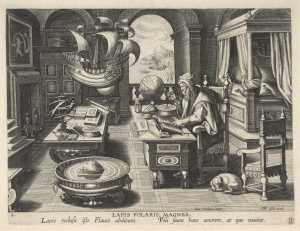Author: Albert Elen
Johannes Stradanus or Giovanni Stradano is the common name of Jan van der Straet, who was born and raised in Flanders, but left in his twenties and spent most of his long and productive life in Italy, and is therefore generally considered more an Italian than a Flemish artist. Karel van Mander, whom he probably never met in person, gives only a short account of his life and work, and even less so does his long-time supervisor Giorgio Vasari (1568)1, but Raffaello Borghini devotes an entire chapter to Giovanni della Strada in his treatise Il riposo (1584) and is the main literary source for biographical data.2
Stradanus received his artistic training in Antwerp as a pupil of Pieter Aertsen, entering the St Luke guild in 1545. Soon after that he left Antwerp and travelled south, staying in Lyon for half a year, before moving on to Venice around 1550. There he met an employee of the grand-ducal Arazzeria Medicea in Florence, Jan Rost, who introduced him there. Between 1550 and 1553 Stradanus worked in Rome, assisting Francesco Salviati in the decorations of the Vatican’s Belvedere, before settling in Florence. There he joined the team of artists (including Jacopo Zucchi and Battista Naldini) assisting in the decorations (frescoes and panel paintings) in the ducal appartments, the Sala dei Duecento and the Salone dei Cinquento in Palazzo Vecchio, under the supervision of Giorgio Vasari (1511-1574). Stradanus also provided designs for series of tapestries, including one of 28 hunting scenes for the Medici villa in Poggio a Caiano, which were delivered between 1561 and 1567. From that time onward Stradanus shifted his interest to making designs for prints, initially inspired on his earlier designs for tapestries. He is most well-known for the large series of 104 prints depicting various hunting scenes, the Venationes Ferarum, Avium, Piscium, Pugnae Bestiariorum […], engraved by several artists and published between 1578 and around 1596 by the engraver and publisher Philips Galle, whom he had met during a short stay in Antwerp when he was there in the service of Don Juan of Austria.3 This series started in 1578 as a recording of the Medici hunting tapestries woven between 1567-1568 after Stradanus’s designs. After this Stradanus spent the rest of his productive life designing more than twenty other print series, including the the Medicae Familiae rerum feliciter gestarum victoriae et triumphi (before 1580, 21 prints), Equile Ioannis austriaci Caroli V imp. f. (before 1579, 43 prints), the Acta apostolorum (1584, 36 prints), two Passion series Passio mors et resurrectio dn. Nostri Jesu Christi (before 1587, resp. 40 and 20 prints), the famous Nova reperta and America retectio (around 1589-1590, resp. 20 and 4 prints), all published by Philips Galle in Antwerp. From Florence, where he lived and worked until his death in 1605, Stradanus sent his design drawings to Galle in Antwerp to be engraved and published.
Stradanus was trained in the style of his master Pieter Aertsen and was influenced by Peter Pourbus. In Rome and Florence he was inspired by the mannerist style of Francesco Salviati and Vasari. After his change of interest to the graphic arts, the mannerist traits diminished giving way to a more classical style also related to the limited dimensions of the prints with heavily populated spatial compositions.
Stradanus has received much scholarly attention during the last two decades, since the unpublished thesis by Bok van Kammen (1977), starting with the catalogue to the exhibition Giovanni Stradano e Dante in Milan by Alessandra Baroni Vannucci (1994), followed by her monograph and complete oeuvre catalogue Jan van der Straet detto Giovanni Stradano flandrus pictor et inventor (1997) and lastly the exhibition Stradanus (1523-1605), Court Artist of the Medici in Bruges (2008) with an extensive catalogue by Baroni and other scholars (2012).
Footnotes
1 G. Vasari, Vite de’ più eccellenti pittori, scultori e architettori italiani, Florence 1568, ed. Milanesi 1906, in the caption on Taddeo Zuccari.
2 R. Borghini, Il riposo, Florence 1584, pp. 579-584 (transl. L.H. Ellis, Il Riposo. Raffaello Borghini, Toronto 2008).
3 Baroni Vannucci 1997, pp. 371-389, no. 693.1-104; New Hollstein 2008b, vol. 3, pp. 133-231, nos. 421-526, ill.


















